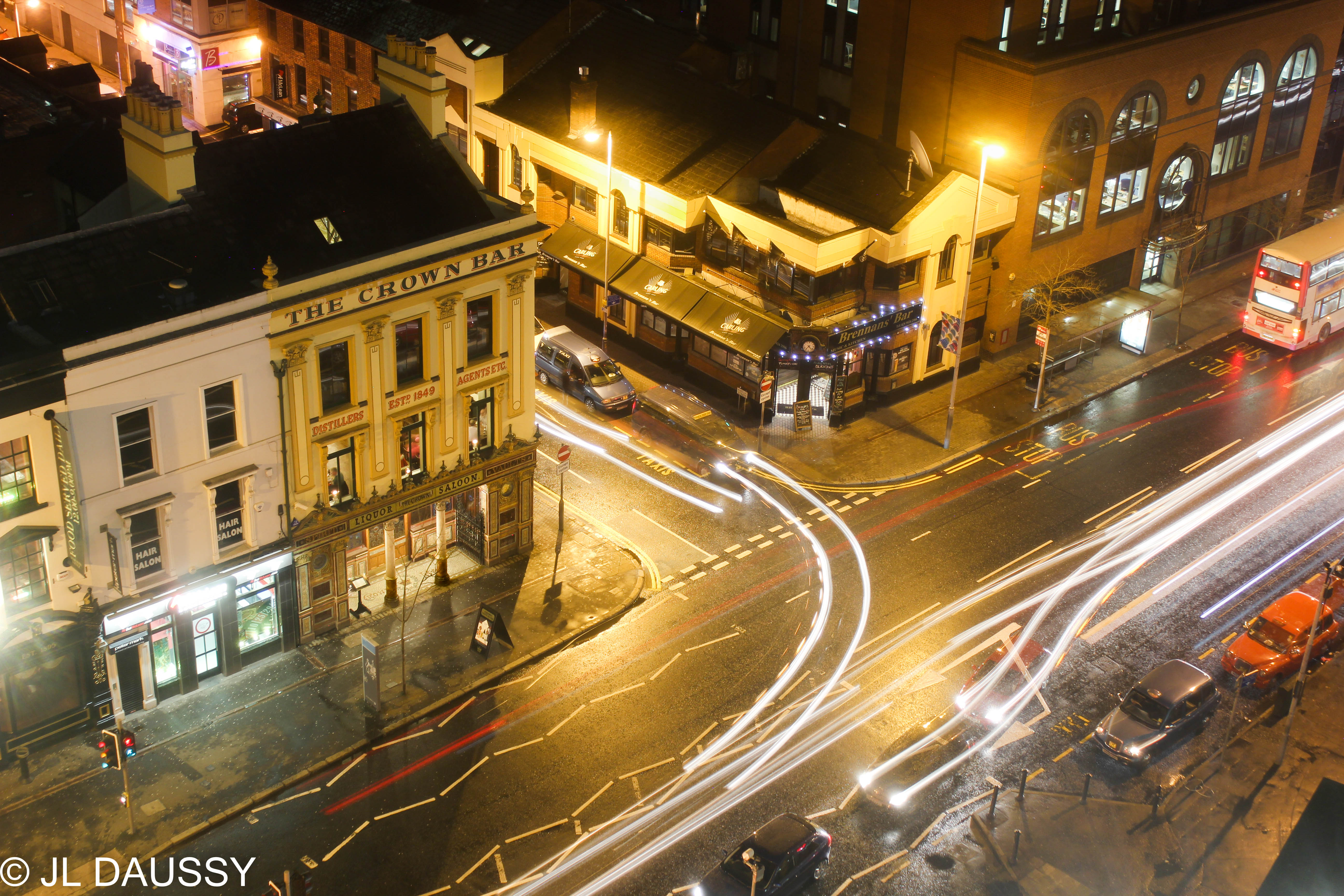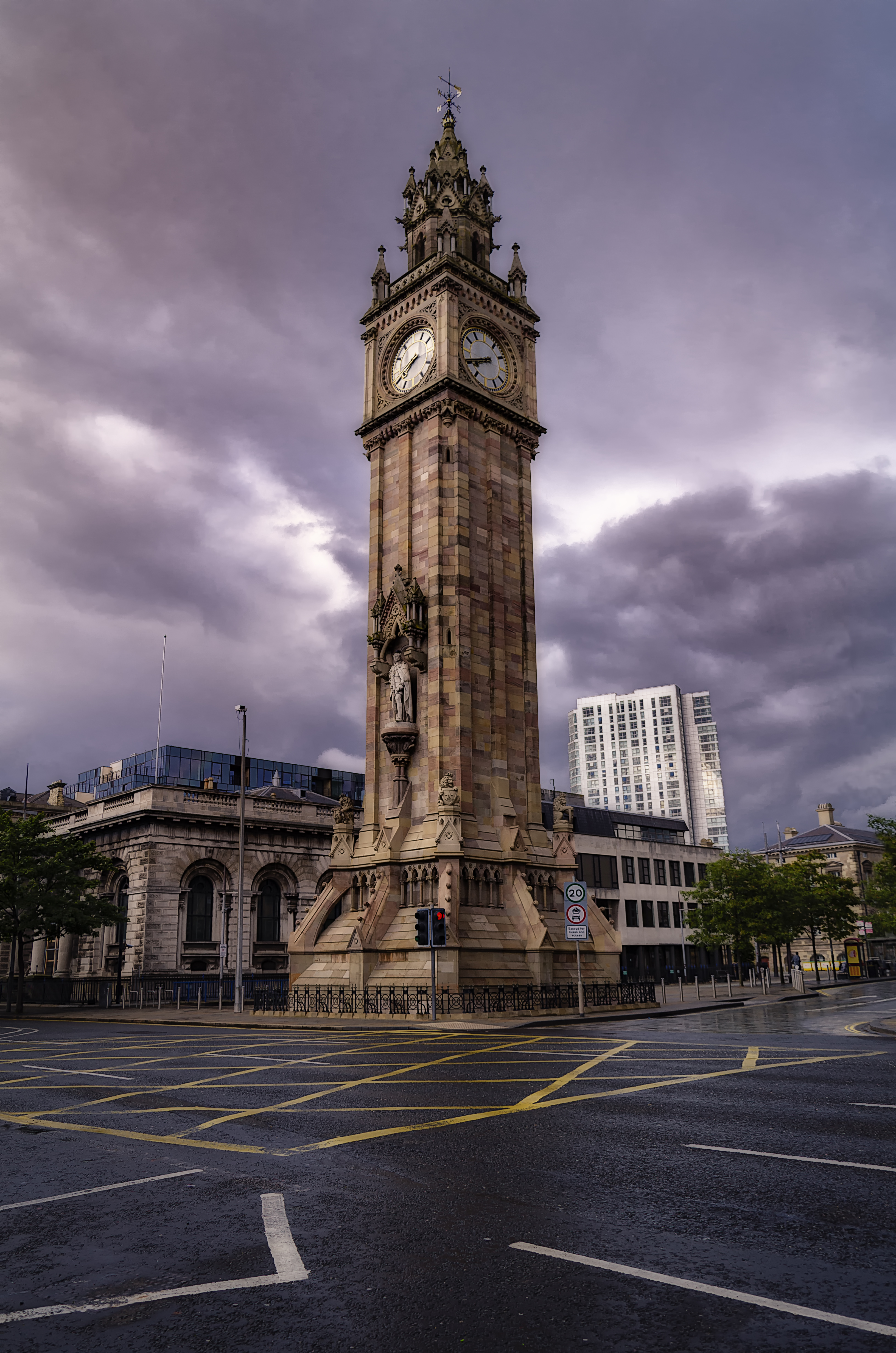|
McHugh's Bar
McHugh's Bar is a pub on Queen's Square in Belfast City Centre, Northern Ireland. It is one of the city's best known pubs and the oldest building in Belfast. History McHugh's was originally built as a private dwelling on the old Town Dock around 1711. Some time after this the dock was demolished and the River Farset was covered, although it still runs under Queen's Square and the adjacent High Street. Between 1715 and 1725 it was converted to a small pub. McHugh's has been given a Grade A Listed Building status by the Environment and Heritage Service. Renovation and current status The original Mchugh's bar was named after well known Belfast publican called Pat Mchugh (Pat the hat) In the 1990s the bar underwent a £1m renovation and expansion, enclosing the neighbouring DuBarry’s Bar, an establishment with a dubious reputation. The previous owners are Botanic Inns, was one of Belfast's largest pub and restaurant companies, whose establishments include The Botanic Inn, The A ... [...More Info...] [...Related Items...] OR: [Wikipedia] [Google] [Baidu] |
Belfast (038), October 2009
Belfast ( , ; from ga, Béal Feirste , meaning 'mouth of the sand-bank ford') is the capital and largest city of Northern Ireland, standing on the banks of the River Lagan on the east coast. It is the 12th-largest city in the United Kingdom and the second-largest in Ireland. It had a population of 345,418 . By the early 19th century, Belfast was a major port. It played an important role in the Industrial Revolution in Ireland, briefly becoming the biggest linen-producer in the world, earning it the nickname " Linenopolis". By the time it was granted city status in 1888, it was a major centre of Irish linen production, tobacco-processing and rope-making. Shipbuilding was also a key industry; the Harland and Wolff shipyard, which built the , was the world's largest shipyard. Industrialisation, and the resulting inward migration, made Belfast one of Ireland's biggest cities. Following the partition of Ireland in 1921, Belfast became the seat of government for Northern Ireland. ... [...More Info...] [...Related Items...] OR: [Wikipedia] [Google] [Baidu] |
Northern Ireland
Northern Ireland ( ga, Tuaisceart Éireann ; sco, label=Ulster-Scots, Norlin Airlann) is a part of the United Kingdom, situated in the north-east of the island of Ireland, that is variously described as a country, province or region. Northern Ireland shares an open border to the south and west with the Republic of Ireland. In 2021, its population was 1,903,100, making up about 27% of Ireland's population and about 3% of the UK's population. The Northern Ireland Assembly (colloquially referred to as Stormont after its location), established by the Northern Ireland Act 1998, holds responsibility for a range of devolved policy matters, while other areas are reserved for the UK Government. Northern Ireland cooperates with the Republic of Ireland in several areas. Northern Ireland was created in May 1921, when Ireland was partitioned by the Government of Ireland Act 1920, creating a devolved government for the six northeastern counties. As was intended, Northern Irela ... [...More Info...] [...Related Items...] OR: [Wikipedia] [Google] [Baidu] |
Listed Building
In the United Kingdom, a listed building or listed structure is one that has been placed on one of the four statutory lists maintained by Historic England in England, Historic Environment Scotland in Scotland, in Wales, and the Northern Ireland Environment Agency in Northern Ireland. The term has also been used in the Republic of Ireland, where buildings are protected under the Planning and Development Act 2000. The statutory term in Ireland is "protected structure". A listed building may not be demolished, extended, or altered without special permission from the local planning authority, which typically consults the relevant central government agency, particularly for significant alterations to the more notable listed buildings. In England and Wales, a national amenity society must be notified of any work to a listed building which involves any element of demolition. Exemption from secular listed building control is provided for some buildings in current use for worsh ... [...More Info...] [...Related Items...] OR: [Wikipedia] [Google] [Baidu] |
Environment And Heritage Service
The Northern Ireland Environment Agency (NIEA) is an executive agency within the Department of Agriculture, Environment and Rural Affairs (DAERA). It is responsible for conservation of Northern Ireland's environment and natural heritage. Originally part of the Department of the Environment (DOENI), the agency was called the Environment and Heritage Service (EHS) until 1 July 2008, and also had responsibility for the historic environment. On 16 May 2016 the DOENI was dissolved and NIEA became part of DAERA. At the same time, the historic environment functions of NIEA were transferred to the Department for Communities. NIEA is responsible for a range of protected areas in Northern Ireland, including eight areas of outstanding natural beauty, 47 national nature reserves, 43 special areas of conservation, and 10 special protection areas. The NIEA employs 630 people as of 2020. Equivalent bodies in other parts of the United Kingdom * England: Environment Agency, Natural Eng ... [...More Info...] [...Related Items...] OR: [Wikipedia] [Google] [Baidu] |
The Botanic Inn
The Botanic Inn, affectionately known as "The Bot", is a bar/nightclub situated near Botanic Gardens in the Queen's Quarter of Belfast, Northern Ireland. Owned by the Moony Hotel Group, formerly the Botanic Inn Group as of 2016. It has been noted as an example of Victorian architecture in Northern Ireland. A writer for the Sunday Mirror The ''Sunday Mirror'' is the Sunday sister paper of the ''Daily Mirror''. It began life in 1915 as the ''Sunday Pictorial'' and was renamed the ''Sunday Mirror'' in 1963. In 2016 it had an average weekly circulation of 620,861, dropping marke ... in London wrote: "If I could own any bar in Belfast, purely for profit, it would be this one." References Pubs in Belfast Restaurants established in 1867 {{NorthernIreland-struct-stub ... [...More Info...] [...Related Items...] OR: [Wikipedia] [Google] [Baidu] |
The Northern Whig
The Northern Whig is a bar housed in a historical building in Belfast, Northern Ireland. It is in the Cathedral Quarter, just to the north of the Belfast City Centre. At various times during its history it has been a gentleman's club and a newspaper and is currently a bar owned by the Horatio Group. The Northern Whig Club In 1795 members including Theobald Wolfe Tone and Henry Joy McCracken met at Cavehill to the north of Belfast, a meeting that was a pivotal step towards the 1798 Rebellion. In 1819 construction began on the current Northern Whig building in Bridge Street, taking its name from the original club. The foundation stone was laid on St. Patrick’s Day, and the building was completed in 1821 as a hotel and gentlemen's club. In 1798 McCracken had been tried and hanged at the Belfast Assembly Rooms, across the road from the building. The Assembly Rooms building was used as a branch of the Northern Bank during the 20th century but is currently vacant. ''The Northern ... [...More Info...] [...Related Items...] OR: [Wikipedia] [Google] [Baidu] |
Henry Downey
Henry Downey (born 27 December 1966) is a former dual player of Gaelic games, who played as a Gaelic footballer at senior level for the Derry county team in the late 1980s, 1990s and early 2000s, where he usually played in at centre half back. He was part of Derry's 1993 All-Ireland Championship winning side, where he was captain. He also won two Ulster Senior Football Championships (1993 and 1998) and four National League (1992, 1995, 1996 and 2000) medals with Derry. He also played hurling. Playing career Downey played club football and hurling with Erin's Own GAC Lavey, with whom he won the 1991 All-Ireland Senior Club Football Championship. He was one of very few players in Ireland to complete this unique double of club and inter-county All-Irelands and almost did the extreme rarity of winning both competitions in the same year in 1993, but Lavey were defeated in the All-Ireland club after winning the Ulster Senior Club Football Championship for the second time. Downey al ... [...More Info...] [...Related Items...] OR: [Wikipedia] [Google] [Baidu] |
The Crown Liquor Saloon
The Crown Liquor Saloon, also known as the Crown Bar, is a pub in Great Victoria Street in Belfast, Northern Ireland. Refurbished in 1885, and at least twice since, it is an outstanding example of a Victorian gin palace, and one of Northern Ireland's best-known pubs. It is owned by the National Trust and is leased to Mitchells & Butlers who run it as a Nicholson's pub. History Opened by Felix O'Hanlon as The Railway Tavern, the pub was then bought by Michael Flanagan. Flanagan's son Patrick renamed and renovated it in 1885. The Crown owes its elaborate tiling, stained glass and woodwork to the Italian craftsmen whom Flanagan persuaded to work on the pub after hours. These craftsmen were brought to Ireland to work on the many new churches being built in Belfast at the time. It was this high standard of work that gave the Crown the reputation of being one of the finest Victorian gin palaces of its time. In 1978, the National Trust, following persuasion by people including Si ... [...More Info...] [...Related Items...] OR: [Wikipedia] [Google] [Baidu] |
Albert Memorial Clock, Belfast
The Albert Memorial Clock (more commonly referred to as the Albert Clock) is a clock tower situated at Queen's Square in Belfast, Northern Ireland. It was completed in 1869 and is one of the best known landmarks of Belfast. History In 1865 a competition for the design of a memorial to Queen Victoria's late Prince Consort, Prince Albert, was won by W. J. Barre, who had earlier designed Belfast's Ulster Hall. Initially Barre was not awarded his prize and the contract was secretly given to Lanyon, Lynn, and Lanyon, who had come second. Following public outcry the contract was eventually awarded to Barre. The construction cost of £2,500 (''2011: £'') was raised by public subscription. The sandstone memorial was constructed between 1865 and 1869 by Fitzpatrick Brothers builders and stands 113 feet tall in a mix of French and Italian Gothic styles. The base of the tower features flying buttresses with heraldic lions. A statue of the Prince in the robes of a Knight of the Garte ... [...More Info...] [...Related Items...] OR: [Wikipedia] [Google] [Baidu] |
Pubs In Belfast
A pub (short for public house) is a kind of drinking establishment which is licensed to serve alcoholic drinks for consumption on the premises. The term ''public house'' first appeared in the United Kingdom in late 17th century, and was used to differentiate private houses from those which were, quite literally, open to the public as "alehouses", "taverns" and "inns". By Georgian times, the term had become common parlance, although taverns, as a distinct establishment, had largely ceased to exist by the beginning of the 19th century. Today, there is no strict definition, but CAMRA states a pub has four characteristics:GLA Economics, Closing time: London's public houses, 2017 # is open to the public without membership or residency # serves draught beer or cider without requiring food be consumed # has at least one indoor area not laid out for meals # allows drinks to be bought at a bar (i.e., not only table service) The history of pubs can be traced to Roman taverns in Br ... [...More Info...] [...Related Items...] OR: [Wikipedia] [Google] [Baidu] |
.png)





